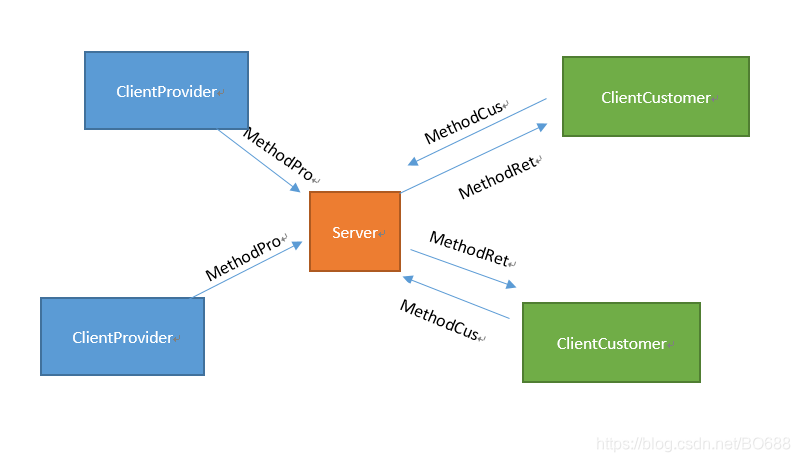RPC著名框架为Dubbo
其中生产者和消费者都需要创建一个接口服务类,通过这个类进行服务调用
生产者有接口实现类
消费者有接口所需的参数
服务中心需要对服务进行管理,和参数的返回
核心难点:利用接口类的构造器进行反射(说法可能不太对)
看下面
public static void main(String[] args) throws InterruptedException {
RPClientPro rpClientPro=new RPClientCus().RPContextApplication();
//重点:接口获取实例
Test1 mc= RpcClientProxy.getProxy(Test1.class,rpClientPro);
//调用方法触发invoke,
System.out.println(mc.SayNumber());
}
public static <T> T getProxy(Class<T> clazz,RPClientPro rpClientPro) {
return (T) Proxy.newProxyInstance(clazz.getClassLoader()
, new Class<?>[]{clazz},
new InvocationHandler() {
public Object invoke(Object proxy, Method method, Object[] args) throws Throwable {
System.out.println("开启事务");
//这里可以获取到参数,Customer在这里进行RPC方法参数传输
System.out.println("关闭事务");
return obj;
}
});
}
RPC中netty数据流程图
这里通讯工具使用netty,使用类序列化和反序列化进行传输即可。
注意Channel和Ctx不可序列化,类包含这个将无法序列化传输。
- 需要开启服务注册中心
- 生产者进行服务传输并且连接
- 消费者进行服务请求
- 服务中心进行服务调用,并且返回

如果想象Dubbo一样使用配置文件
就需要这个进行文件读取

public Beans(String configxml) throws Exception {
SAXReader reader = new SAXReader();
URL sources = Beans.class.getClassLoader().getResource(configxml);
Document document = reader.read(sources);
List<Element> elements = document.getRootElement().elements();
for (Element element : elements) {
String id = element.attributeValue("id");//获取id属性
String path = element.attributeValue("path");//获取class属性
String clazz = element.attributeValue("class");//获取class属性
try {
beansList.add(Class.forName(path));
beansPath.put(id,path);
beansObject.put(id,Class.forName(clazz).newInstance());
}catch (Exception e){
}
}
}
<?xml version="1.0" encoding="UTF-8" ?>
<!--自定义 父节点-->
<beans>
<!--自定义 子节点-->
<beans id="cat" path="com.PRC.Service.Test1" />
<beans id="dog" path="com.PRC.Service.Test"/>
</beans>
或者你想要使用注解直接修饰interface
@Target(ElementType.TYPE)
@Retention(RetentionPolicy.RUNTIME)
public @interface ProvideMethod {
}
@ProvideMethod
public interface Test1 {
int SayNumber();
String SayString (String param);
}
这个获取注解标识的interface
Reflections reflections = new Reflections();
Set<Class> classes = reflections.getTypesAnnotatedWith(ProvideMethod.class);
pom.xml
<?xml version="1.0" encoding="UTF-8"?>
<project xmlns="http://maven.apache.org/POM/4.0.0"
xmlns:xsi="http://www.w3.org/2001/XMLSchema-instance"
xsi:schemaLocation="http://maven.apache.org/POM/4.0.0 http://maven.apache.org/xsd/maven-4.0.0.xsd">
<modelVersion>4.0.0</modelVersion>
<groupId>com.conpany.RPC</groupId>
<artifactId>RPC</artifactId>
<version>1.0-SNAPSHOT</version>
<dependencies>
<dependency>
<groupId>io.netty</groupId>
<artifactId>netty-all</artifactId>
<version>4.1.50.Final</version>
</dependency>
<dependency>
<groupId>com.alibaba</groupId>
<artifactId>fastjson</artifactId>
<version>1.2.36</version>
</dependency>
<dependency>
<groupId>cn.hutool</groupId>
<artifactId>hutool-all</artifactId>
<version>4.3.1</version>
</dependency>
<dependency>
<groupId>org.slf4j</groupId>
<artifactId>slf4j-api</artifactId>
<version>1.7.30</version>
</dependency>
<dependency>
<groupId>org.reflections</groupId>
<artifactId>reflections</artifactId>
<version>0.9.10</version>
</dependency>
<dependency>
<groupId>org.projectlombok</groupId>
<artifactId>lombok</artifactId>
<version>1.16.18</version>
</dependency>
<!-- dom4j 依赖-->
<dependency>
<groupId>org.dom4j</groupId>
<artifactId>dom4j</artifactId>
<version>2.1.1</version>
</dependency>
<dependency>
<groupId>junit</groupId>
<artifactId>junit</artifactId>
<version>4.11</version>
<scope>test</scope>
</dependency>
</dependencies>
</project>





















 5553
5553











 被折叠的 条评论
为什么被折叠?
被折叠的 条评论
为什么被折叠?








